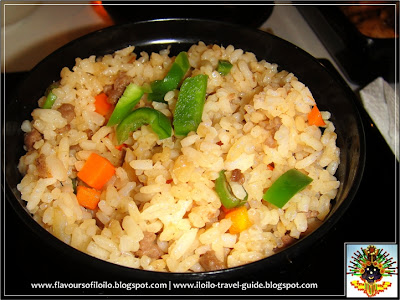I turned Japanese later that night as I went with the members of the Iloilo Bloggers to a food tasting session at Mr. Misono upon the invitation of Mr. Gian Javellana, owner of the Japanese fastfood joint.. “It’s Tokyo-Tokyo meets Teriyaki Boy” opens up Gian as he explained the concept of his restaurant. I couldn’t agree more having tried those two restaurants in Manila many times.
Unlike most Japanese restaurants in Iloilo City, Mr. Misono has the fastfood feel that doesn’t seem to be intimidating. “Mr. Misono is trying to bridge the gap between ordinary Ilonggos who are not attuned with Japanese specialties but are willing to try, budget wise ” he said. Thus a big menu board that announces their specialties and the respective prices dominates the counter.
Samplers of California maki and sashimi came to our table and after a series of clicks and flashes – all were devoured with gusto. Gian shared despite his low prices customers are assured of the food’s quality. “We get our stocks from Japanese stores in Manila like most other restaurants and hotels which offer Japanese cuisine”.
He shared some anecdotes while we waited for our next dish but the one with the sashimi drew the most laughs. It turns out someone ordered sashimi not having any idea about and when it came the customer gave it a long gaze and said “Is this a joke? Why is this fish raw?” From then on, Gian said he tries to be in the restaurant as often as he could so he can explain each dish to some customers.
Like the Beef Sukiyaki, it’s a dish with rice noodles, beef strips and vegetables cracked with fresh egg before serving. “I make it a point to tell them that it has a sweet broth so that they will be ready for it”. It was a delicious soup – perfectly seasoned for me with just right mix of sweetness and flavour. The beef and vegetables were good too that I finished my bowl in no time.
By the way, the raw fish that was complained before was cooked by Gian – wakadori style though it’s not part of the menu. But there’s Chicken Wakadori that comes in original or hot and spicy blend. Perfectly fried chicken pieces that smothered with delectable sauce that you’d even lick the bones off!
A bento meal of their Mixed Misono served with Mr. Misono Fried Rice and Sautéed sprouts came next. It had a combination of chicken, beef and seafood pieces – a perfect order for those who can’t make up their minds.
This is where the food memories of Tokyo-Tokyo come in – I can still remember our tray oozing with so much grease like we can see ourselves on the plate. But surprisingly Mr. Misono has found a way to lessen the grease yet still make the perfectly fried and sautéed bento meal.
Finally there’s Tai Teppan, fried fish fillet with vegetables smothered with a savoury sauce. It was a fitting end to a night where our all our palates turned Japanese during a wonderful meal all courtesy of Mr. Misono.
Mr. Misono by Misono Express
Casa Plaza, Corner Gen. Luna – Iznart Streets, Iloilo City
Monday to Saturday, 10 am to 9 pm
(033) 336-4189
(033) 329-0487
Monday to Saturday, 10 am to 9 pm
(033) 336-4189
Misono Express
108 N- Jalandoni St. Brgy. Lourdes Jaro, Iloilo City(033) 329-0487










